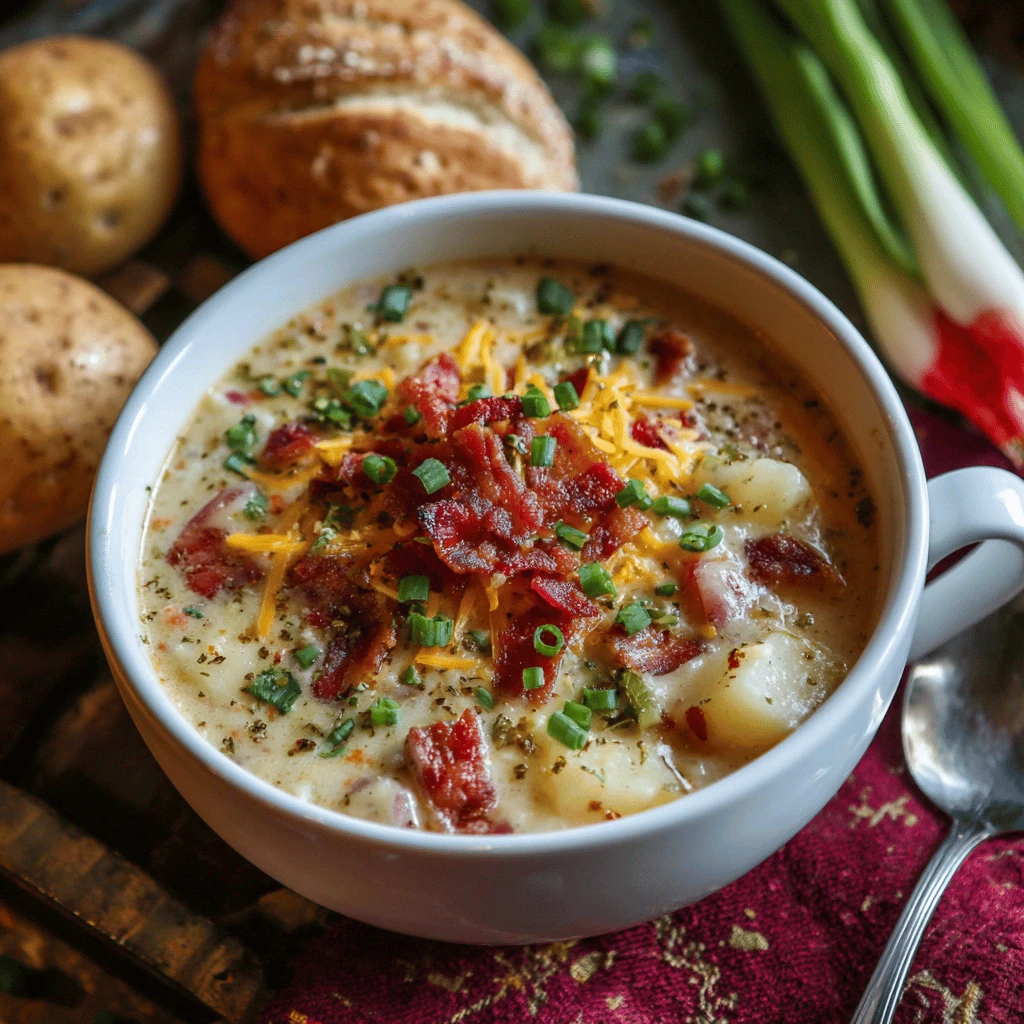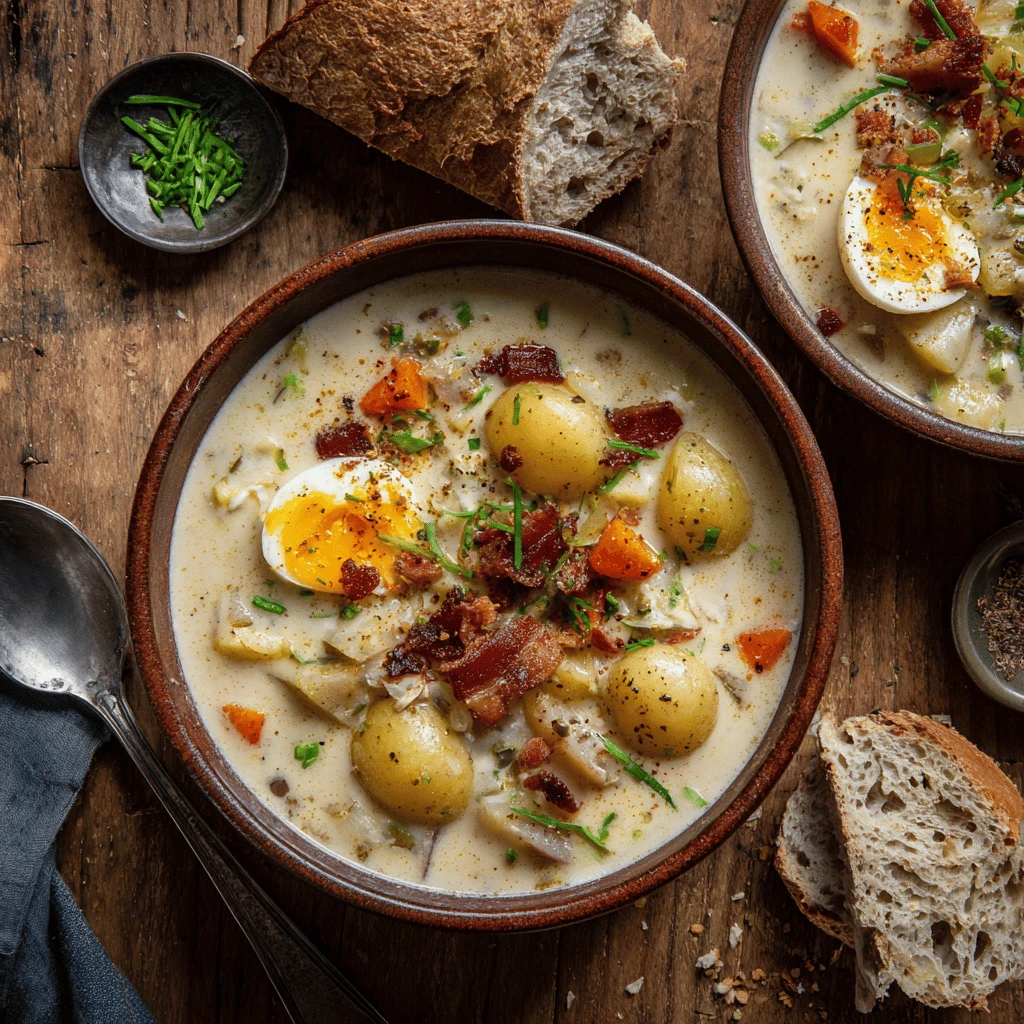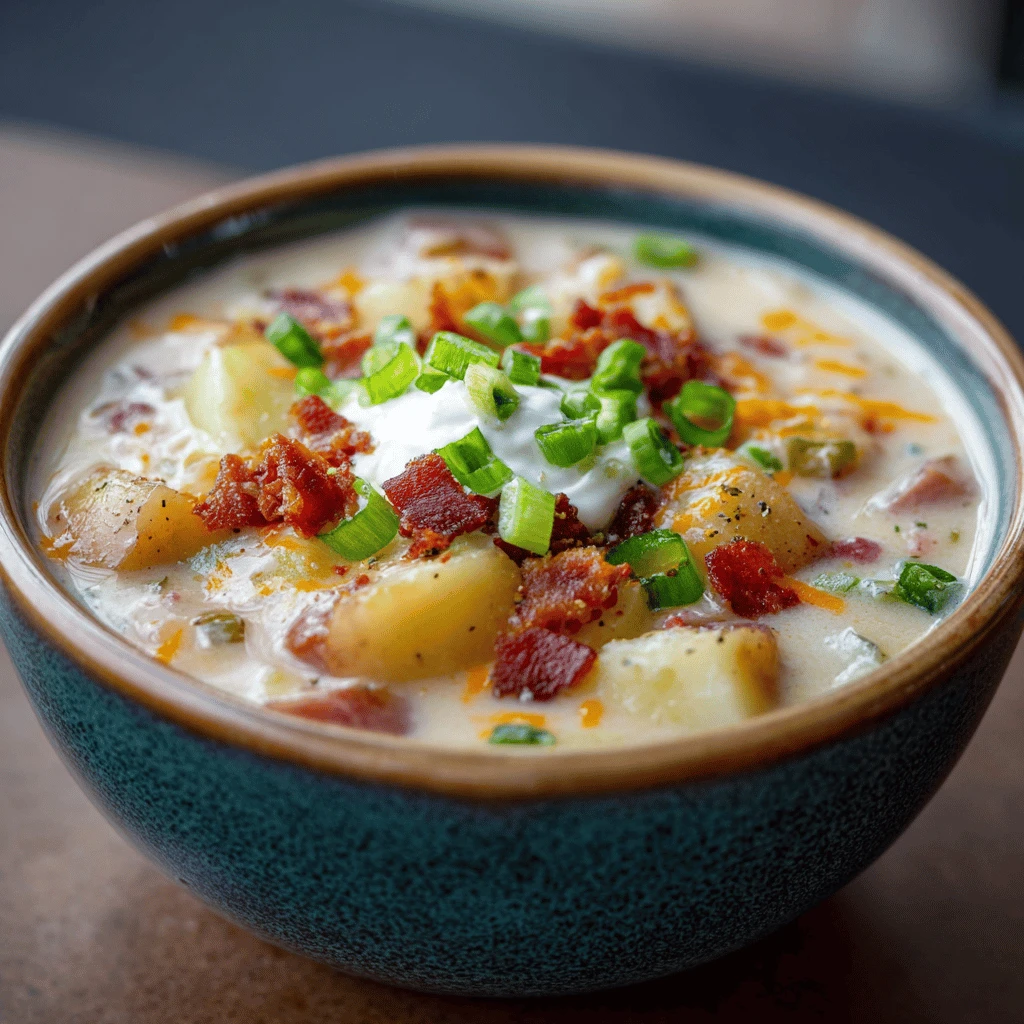Hearty Potato Chowder
A Bowlful of Comfort: Exploring the Depths of Potato Chowder
Potato chowder. The name itself conjures images of cozy kitchens, crackling fireplaces, and the simple pleasure of a warm, comforting bowl on a chilly day. More than just a soup, potato chowder is a culinary hug, a dish that transcends generations and regional boundaries. But what makes a truly exceptional potato chowder? This article delves into the secrets, from selecting the perfect potatoes to mastering the creamy base and adding those special touches that elevate it from ordinary to extraordinary.
The Foundation: Potatoes, Broth, and Cream
At the heart of any good potato chowder lies, unsurprisingly, the potatoes. The choice of potato can significantly impact the texture and flavor of the final dish. Waxy potatoes like Yukon Golds hold their shape well and offer a creamy texture, while starchier varieties such as Russets tend to break down, creating a thicker, more rustic chowder. Experimenting with a combination of both can provide the best of both worlds.
The broth is equally important. While water can be used in a pinch, using chicken or vegetable broth adds depth of flavor that enhances the overall experience. A homemade broth, simmered with aromatic vegetables and herbs, will undoubtedly elevate your chowder to new heights.
And then there’s the cream. The type of dairy used dictates the richness and consistency of the chowder. Heavy cream delivers the most luxurious texture, while half-and-half provides a lighter alternative. Some recipes even incorporate milk for a thinner, less calorie-dense version. The key is to add the dairy gradually, stirring constantly to prevent curdling and ensure a smooth, velvety finish.
Choosing Your Potatoes Wisely
- Yukon Gold: Creamy, buttery flavor, holds its shape well.
- Russet: Starchy, breaks down easily, thickens the chowder.
- Red Potatoes: Waxy, slightly sweet, good for adding color and texture.
Broth Basics
- Chicken Broth: Adds savory depth and richness.
- Vegetable Broth: Lighter, suitable for vegetarian or vegan variations.
- Homemade Broth: The ultimate flavor enhancer, customizable to your preferences.
Creamy Considerations
- Heavy Cream: Rich, decadent, provides the thickest texture.
- Half-and-Half: Lighter than heavy cream, still adds creaminess.
- Milk: Thinnest option, use with a roux or cornstarch for thickening.
Elevating the Flavor: Key Ingredients and Techniques
Beyond the basic ingredients, several key components can transform a simple potato chowder into a culinary masterpiece. Sautéing aromatic vegetables like onions, celery, and garlic in butter or olive oil before adding the broth builds a flavorful foundation. Bacon or pancetta adds a smoky, savory element that complements the potatoes beautifully.
Fresh herbs, such as thyme, parsley, and chives, brighten the flavor and add a touch of freshness. A bay leaf simmered in the broth imparts a subtle, aromatic complexity. A dash of hot sauce or a pinch of red pepper flakes provides a welcome kick.
The cooking technique also plays a crucial role. Simmering the potatoes gently in the broth allows them to absorb the flavors without becoming mushy. Using an immersion blender to partially puree the chowder creates a creamy texture while leaving some chunks of potato for added interest.
Aromatic Vegetables: The Flavor Base
- Onions: Yellow or white onions, diced and sautéed until translucent.
- Celery: Adds a subtle sweetness and vegetal note.
- Garlic: Minced or crushed, adds pungent aroma and flavor.
Meaty Additions: Smoky Savoryness
- Bacon: Cooked until crispy, adds smoky flavor and texture.
- Pancetta: Italian bacon, similar to bacon but with a richer flavor.
- Ham: Diced ham adds a salty, meaty element.
Herby Highlights: Freshness and Aroma
- Thyme: Earthy, slightly lemony flavor.
- Parsley: Fresh, clean flavor.
- Chives: Mild onion flavor.
- Bay Leaf: Adds subtle, aromatic complexity (remove before serving).
Variations and Adaptations: Making it Your Own
One of the beautiful things about potato chowder is its versatility. It can be easily adapted to suit different dietary needs and preferences. For a vegetarian or vegan version, simply use vegetable broth and substitute the dairy with plant-based alternatives like coconut milk or cashew cream.
Adding different vegetables, such as corn, carrots, or leeks, can create interesting flavor and texture combinations. Seafood lovers can incorporate shrimp, crab, or clams for a hearty seafood chowder.
Experiment with different spices and seasonings to customize the flavor profile. Smoked paprika adds a smoky depth, while curry powder provides a warm, exotic touch. A squeeze of lemon juice brightens the flavors and adds a touch of acidity.
Vegetarian and Vegan Options
- Vegetable Broth: Substitute for chicken broth.
- Coconut Milk: Adds richness and creaminess.
- Cashew Cream: Blended cashews and water, a creamy alternative to dairy.
Vegetable Variations
- Corn: Adds sweetness and texture.
- Carrots: Adds sweetness and color.
- Leeks: Mild onion flavor.
Spicy Twists
- Smoked Paprika: Adds smoky depth.
- Curry Powder: Adds warm, exotic flavor.
- Hot Sauce: Adds a kick of heat.
Serving and Garnishing: The Finishing Touches
The presentation of your potato chowder is just as important as the flavor. Serve it hot in warm bowls, garnished with your favorite toppings. Crispy bacon bits, chopped chives, and a dollop of sour cream or Greek yogurt are classic choices.
A drizzle of olive oil or a swirl of pesto adds a touch of elegance. Serve with crusty bread or crackers for dipping. A simple side salad can complete the meal.
Classic Garnishes
- Crispy Bacon Bits: Adds salty, smoky crunch.
- Chopped Chives: Adds fresh onion flavor and color.
- Sour Cream or Greek Yogurt: Adds tangy creaminess.
Elegant Touches
- Drizzle of Olive Oil: Adds richness and flavor.
- Swirl of Pesto: Adds herbaceous flavor and color.
Perfect Pairings
- Crusty Bread: For dipping into the creamy chowder.
- Crackers: A crunchy accompaniment.
- Side Salad: A light and refreshing counterpoint.
Storing and Reheating: Preserving the Flavor
Potato chowder is best enjoyed fresh, but leftovers can be stored in the refrigerator for up to three days. To prevent the potatoes from becoming mushy, store the chowder in an airtight container.
Reheat gently over low heat, stirring occasionally. Avoid boiling, as this can cause the dairy to curdle. If the chowder has thickened too much, add a splash of milk or broth to thin it out.
Storage Tips
- Airtight Container: Prevents drying and flavor absorption.
- Refrigerator: Store for up to three days.
Reheating Instructions
- Low Heat: Prevents curdling.
- Stir Occasionally: Ensures even heating.
- Add Liquid: Thins out the chowder if necessary.
FAQ: Frequently Asked Questions about Hearty Potato Chowder
Why is my potato chowder so thin?
The thickness of potato chowder depends on the type of potatoes used and the amount of liquid. Starchier potatoes like Russets will break down and thicken the chowder, while waxy potatoes like Yukon Golds will hold their shape. If your chowder is too thin, you can add a slurry of cornstarch and water, or puree a portion of the chowder with an immersion blender.
Can I freeze potato chowder?
Freezing potato chowder is not generally recommended, as the dairy can separate and become grainy when thawed. However, if you must freeze it, use a heavy cream base and thaw it slowly in the refrigerator. You may need to stir it vigorously to recombine the ingredients.
What kind of potatoes are best for potato chowder?
The best potatoes for potato chowder are Yukon Golds, as they offer a creamy texture and hold their shape well. However, you can also use a combination of Yukon Golds and Russets for a thicker, more rustic chowder.
How do I prevent my potato chowder from curdling?
To prevent potato chowder from curdling, add the dairy gradually, stirring constantly. Avoid boiling the chowder after adding the dairy. You can also temper the dairy by whisking a small amount of the hot chowder into the cold dairy before adding it to the pot.
Can I make potato chowder in a slow cooker?
Yes, you can make potato chowder in a slow cooker. Sauté the onions, celery, and garlic in a skillet before adding them to the slow cooker. Add the potatoes, broth, and seasonings, and cook on low for 6-8 hours, or on high for 3-4 hours. Stir in the dairy during the last 30 minutes of cooking time.




